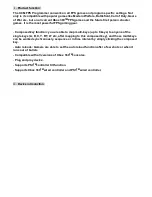
Operating Instructions for Tractor A-Frames
Type: GRANIT Index group 778
8
5.2.
Operating the tractor A-frame
ATTENTION: Before entering the hazardous area, secure the tractor against
unauthorised restarting and lower the implement completely. UNFALLGEFAHR!
5.2.1.
Coupling of equipment and operation
1.
Check that the attachment categories between the tractor and the equipment A-frame
correspond and that the tractor is technically compatible with the equipment.
ATTENTION: Mismatches can lead to serious accidents.
2.
Fixing the actuating cable to the unlocking lever.
3.
Pull the actuating cable to open the tensioning hooks (fig. 2).
ATTENTION: Do not place the actuating cable around your hand or finger as a loop,
there is a danger of crushing and amputation.
4.
Lift the three-point attachment to pick up the equipment. Release the actuating cable to
engage the locking pawl.
5.
Lower and secure the vehicle against unauthorised use.
6.
Check the mechanical locking and the free movement of the equipment.
7.
Removal and safe stowage of the actuating cable.
ATTENTION: Only hook the actuating cable onto the tractor A-frame during the
hitching process. Clamping the actuating cable can unintentionally unlock the
implement. Risk of accident!
8.
Testing the secure locking of the locking pawl on the tensioning hook.
9.
Secure the locking pawl against unintentional release with the cotter pin (Fig. 3).
10.
The equipment A-frame must rest completely on the tractor A-frame.
ATTENTION: Inadequate locking of the locking pawl and a missing spring cotter pin
can lead to serious accidents due to loss of the implement. The tensioning hook must
rest completely against the locking pawl.
ATTENTION: The maximum permitted speed on public roads with closed asphalt
surface, with semi-mounted equipment is 25km/h. On all other roads and dirt roads
the maximum speed must not exceed 6km/h.
5.2.1.1.
Adjusting the tensioning hook
NOTE: Only carry out adjustment in the assembled state to check the setting
immediately (see Fig. 4).
a.
Loosen the lock nut (A) and the retaining nut (B).
b.
Adjust the tension hook (C) by turning the retaining screw (D) until the locking pawl (E)
and the tension hook (C) are completely on top of each other.
c.
After adjustment tighten the retaining nut (B) and secure with the lock nut (A).
ATTENTION: Insufficient adjustment and securing can cause the connection to
become loose. Risk of accident!
5.2.2.
Uncoupling equipment
1.
Set the equipment down on a safe and stable surface.































